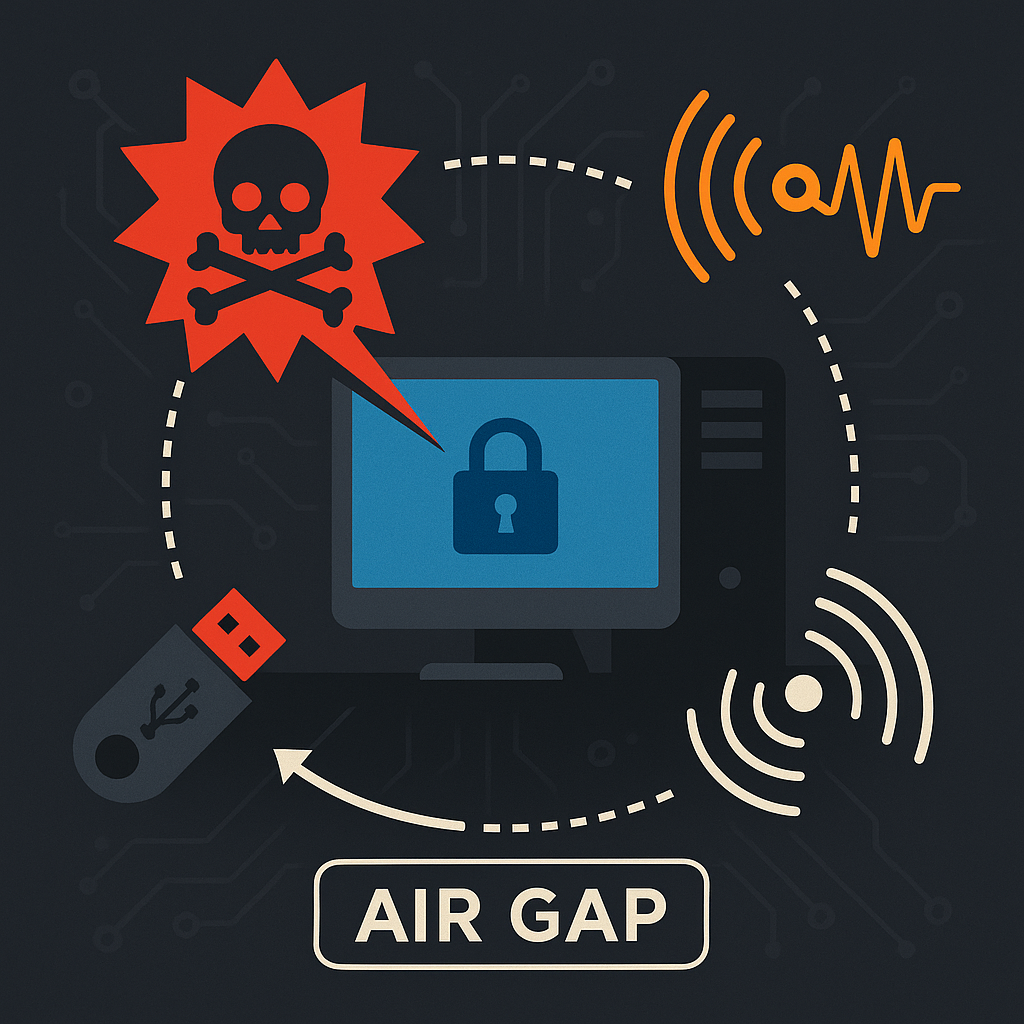Introduction
Air-gapped systems—computers or networks that are physically isolated from unsecured networks like the internet—are often considered a last line of defense. They’re used in environments where data sensitivity or operational security is paramount. But despite the perceived security of these isolated systems, there is a growing list of malware strains that have successfully breached air gaps using creative and unconventional methods. Below is an overview of real-world examples that demonstrate how attackers have managed to bypass air gaps—along with the specific techniques used.
Stuxnet
Year: 2010
Target: Iranian nuclear facilities (Natanz)
Purpose: Industrial sabotage
How it crossed the air gap:
- Delivered via infected USB drives.
- Exploited multiple zero-day vulnerabilities to spread inside the network.
- Specifically targeted Siemens Step7 PLCs used in centrifuge control systems.
Remarks:
Stuxnet was one of the first publicly known cyber weapons to successfully cross an air gap and cause physical damage. It’s widely believed to have been developed by state-sponsored actors.
Ramsay Framework
Year: Discovered in 2020
Target: High-value, air-gapped environments
Purpose: Document harvesting and exfiltration
How it crossed the air gap:
- Propagates via USB drives and network shares.
- Exploits vulnerabilities in Microsoft Office (e.g., CVE-2017-0199 and CVE-2017-11882).
- Gathers sensitive documents (Word, PDF, etc.) for later staged exfiltration.
Remarks:
Ramsay demonstrates that attackers can prepare malware to quietly operate within isolated systems over long periods, especially when removable media is part of the operational workflow.
GoldenJackal
Year: Publicly reported in 2024
Target: European government systems
Purpose: Espionage
How it crossed the air gap:
- Delivered via custom USB worms, potentially through supply chain or insider access.
- Collected sensitive documents, encryption keys, and emails.
- Details on exfiltration remain classified, though removable media and possibly RF-based transmission are suspected.
Remarks:
GoldenJackal illustrates how sophisticated actors can build bespoke toolchains for specific, high-security environments.
PixHell and Fansmitter
Target: Desktop and server-class systems with acoustic or visual peripherals
Purpose: Covert data exfiltration
How they crossed the air gap:
PixHell:
- Uses modulated brightness patterns on LCD screens to generate high-frequency acoustic signals.
- These signals are then picked up by nearby microphones on smartphones or laptops.
Fansmitter:
- Modulates CPU workloads to control fan speed and emit acoustic signals.
- These patterns can be interpreted by nearby microphones as binary data.
Remarks:
Both attacks rely on components not traditionally considered security risks—monitors and fans—turning them into unintentional transmission devices.
PowerHammer
Year: 2018
Target: Desktop PCs in secured environments
Purpose: Data exfiltration via power lines
How it crossed the air gap:
- Malware on the target system varies CPU workload to create specific power fluctuations.
- These fluctuations are detectable on power lines connected to the system and can be decoded externally.
Remarks:
PowerHammer highlights that even power infrastructure can act as a data transmission medium if the attacker controls the endpoint.
AirHopper and LANTENNA
Purpose: Electromagnetic-based data exfiltration
AirHopper:
- Uses the video card to emit radio signals via the display cable.
- Mobile phones with FM radio receivers can detect the signal within a few meters.
LANTENNA:
- Utilizes Ethernet cables to emit RF signals by manipulating the data bus.
- The emitted RF can be received using AM radio antennas.
Remarks:
These techniques demonstrate how electromagnetic leakage can be intentionally exploited to cross network boundaries.
BadBIOS (Alleged)
Year: Reported in 2013
Target: Multi-platform environments
Purpose: Unknown (likely espionage)
How it allegedly crossed the air gap:
- Claimed to use ultrasonic transmissions between systems via built-in speakers and microphones.
- Also allegedly used firmware persistence mechanisms.
Remarks:
While unverified and controversial, the BadBIOS story led to further academic research into ultrasonic data transfer and BIOS-level implants.
Conclusion
Air-gapped systems provide strong baseline protection, but they are not impenetrable. Many successful breaches have relied on physical access, compromised removable media, or even emissions that weren’t originally considered security-relevant (like sound or EM waves). Organizations operating air-gapped environments must consider the full spectrum of attack surfaces—including power supplies, peripherals, and human behavior—and implement rigorous security controls beyond software firewalls and physical disconnection.
Some defensive measures include:
- Strict control over USB and removable media.
- Disabling or physically removing unused audio, RF, and video components.
- Using electromagnetic shielding and power-line filters.
- Deploying anomaly detection systems for non-networked endpoints.
Air gaps are just one part of a layered security model. In a world of increasingly creative adversaries, they are a necessary—but no longer sufficient—barrier.

Leave a Reply